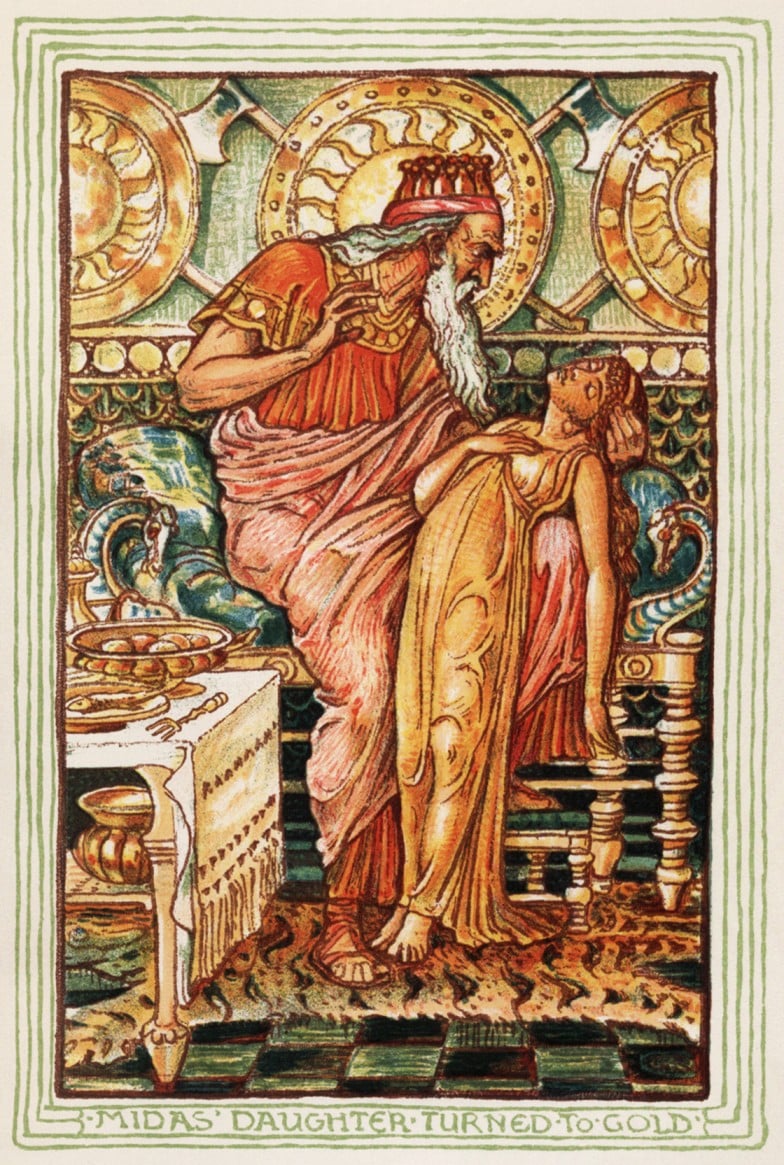
One of the most famous characters from Greek mythology is King Midas. He was the king who, according to legend, turned anything he touched into gold. While many things in Greek mythology are obviously just stories, various other things have been confirmed by modern research. What about this legendary king? Did King Midas really exist, or was he just fictional?
Who was King Midas?
First of all, let us establish who he was said to have been according to the legend. He appears in the writings of various ancient writers, such as the Greek historian Herodotus, the Greek philosopher Plutarch, and the Latin writers Hyginus and Ovid. Many of these records give contradictory accounts about Midas, but they all agree on one thing: he was fabulously wealthy.
The most famous account of Midas’ wealth comes from Ovid, writing in the first century AD. In this story, the god Dionysus offers Midas one wish. Midas wishes for everything he touches to turn to gold. Dionysus grants this wish. At first, Midas is overjoyed, but he soon comes to hate his ‘gift’, since even his food turns to gold – and in one version, even his own daughter!
Another detail that most accounts agree on is that Midas was the king of Phrygia in Anatolia, ruling around the time of the Trojan War. Additionally, they mostly agree that he was the son of a king named Gordias. This Gordias, supposedly, founded the grand city of Gordium, which was the capital city of the Phrygian Kingdom.
Did a King Named Midas, Mentioned in Greek Mythology Really Exist?
Ancient records reveal that a king named Midas really did exist. In fact, there was more than one king with that name. Herodotus mentions a king named Midas who was the grandfather of Adrastus, a contemporary of Croesus of Lydia. That would place this Midas in the late seventh century BC.
Herodotus also mentions a slightly earlier king by that name. According to him, there was a king of Phrygia named ‘Midas son of Gordias’ who donated an impressive golden throne to the Oracle of Delphi. Herodotus specifically says that Midas did this before King Gyges of Lydia gave a donation to the oracle. Since Gyges lived in the early seventh century BC, this shows that the ‘Midas son of Gordias’ mentioned by Herodotus must have been active before then.
However, archaeology shows that the sanctuary at Delphi did not exist before the ninth century BC, so this Midas must have lived between the ninth century and the end of the eighth century BC. The fact that Herodotus specifically calls this Midas ‘son of Gordias’ is significant, since the Midas of Greek mythology was the son of Gordias.
How Assyrian Records Prove That King Midas Really Did Exist
Assyrian records corroborate Herodotus’ claim of a Midas who lived within that period. In the eighth century BC, the Assyrians were trying to push further and further into Anatolia. Coming from the east, this brought them into conflict with the Kingdom of Phrygia.
Contemporary documents from the reign of Sargon II refer to a king of Anatolia named ‘Mita’. It is widely believed that this ‘Mita’ is the Assyrian form of the name ‘Midas’. This confirms that a king called Midas really did exist and really did rule part of Anatolia in that era. These records refer to Mita as the king of the Mushki, a people closely associated with the Phrygians.
Sargon’s campaigns occurred in the second half of the eighth century BC. King Midas (or ‘Mita’) is first mentioned as an enemy of the Assyrians, warring against them at Carchemish in eastern Anatolia. Shortly after this, the Assyrian records mention him as their ally. Although they do not provide much information about him, they do indicate that he was a very powerful king, which is consistent with the Greek legends about King Midas.
The Historical Kingdom of the Real Midas
The Greek records almost completely consistently associate King Midas with the Kingdom of Phrygia. And since he was allegedly immensely wealthy, this obviously means that he was reigning over Phrygia when it was a very powerful kingdom.
The facts about the Kingdom of Phrygia support the conclusion that Midas really did exist. Historically, the Phrygians first appear in Anatolia just after the fall of the Hittite Empire. This empire had been ruling almost all of Anatolia until its collapse. The Phrygians likely filled the power vacuum. Since ancient Greek sources claim that Phrygians migrated from the Balkans, archaeological finds of Balkan pottery in western Anatolia in the 12th century BC is likely a trace of this migration.
Archaeology also reveals that the Kingdom of Phrygia did not become powerful until the eighth century BC. Since the Midas of Greek legend was supposedly incredibly wealthy, yet he was the king of Phrygia, this means that the Midas of Greek legend must be placed in the eighth century BC. He cannot have been an earlier king, because Phrygia was not a powerful kingdom before that century. This confirms that the Midas of Greek legend was the real, historical King Midas who lived in the eighth century BC.
See all the latest news from Greece and the world at Greekreporter.com. Contact our newsroom to report an update or send your story, photos and videos. Follow GR on Google News and subscribe here to our daily email!



